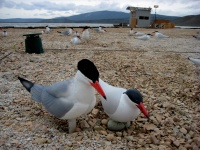Lower Klamath NWR is a mix of seasonally and permanently flooded wetlands and impoundments located just south of Klamath Falls, OR on the Oregon-California border and is owned and managed by the U.S. Fish and Wildlife Service as part of the Klamath Basin NWR Complex. Historically, Caspian terns nested (15-30 pairs) on low-lying tule-mat islands located within the Refuge from at least 1955 to 1976, but have not nested there since. Lower Klamath NWR is listed as one of five sites in interior Oregon and northeastern California where resource managers intend to create nesting habitat for Caspian terns in an effort to provide alternative habitat for the large tern colony on East Sand Island in the Columbia River estuary.
 The U.S. Army Corps of Engineers, in partnership with the U.S. Fish and Wildlife Service, constructed two new islands in the Refuge during the 2009-2010 non-breeding season explicitly as Caspian tern nesting habitat. One new island is a one-acre silt-core island located in the Orems Unit, near the eastern boundary of the Refuge, and the other new island is a 0.8-acre floating island located in Sheepy Lake, near the western boundary of the Refuge.
The U.S. Army Corps of Engineers, in partnership with the U.S. Fish and Wildlife Service, constructed two new islands in the Refuge during the 2009-2010 non-breeding season explicitly as Caspian tern nesting habitat. One new island is a one-acre silt-core island located in the Orems Unit, near the eastern boundary of the Refuge, and the other new island is a 0.8-acre floating island located in Sheepy Lake, near the western boundary of the Refuge.
Only the floating island in Sheepy Lake can potentially support Caspian tern nesting during the 2010 nesting season. Due to severe drought in the Upper Klamath Basin, no water is available to flood the Orems Unit and create nesting habitat at the one-acre island in that impoundment. Water levels in Sheepy Lake will be maintained throughout the tern nesting season, sufficient to keep the island afloat. Caspian tern decoys and audio systems that broadcast Caspian tern calls were installed on the Sheepy Lake tern island in an effort to attract terns to nest at the site.



